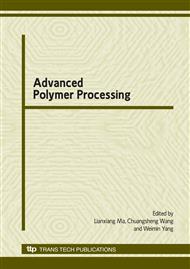p.119
p.125
p.130
p.134
p.137
p.143
p.149
p.154
p.160
Thermal Conductivity and Mechanical Properties of Silicone Rubber Filled with Different Particle Sized SiC
Abstract:
Micro- and nano- silicone carbide particles are used as heat conductive fillers of methyl vinyl silicone rubber, and the influence of filler amount, particle size and the surface treatment of filler on the thermal conductivities and mechanical properties of silicone rubber are studied. The results show that the thermal conductivities of silicone rubber are improved, but the mechanical properties are worse with the increase of the amount of fillers. The composite filled with smaller sized silicone carbide has a better thermal conductivity than that filled with large particles in a relatively high filling fraction, and composite filled with different sized silicone carbide has different mechanical properties at the same filling amount. Treatment of fillers with coupling agent (KH-560, A-171) has active impacts on the thermal conductivity but negative impacts on mechanical properties of the filled silicone rubber.
Info:
Periodical:
Pages:
137-142
Citation:
Online since:
December 2009
Authors:
Price:
Сopyright:
© 2010 Trans Tech Publications Ltd. All Rights Reserved
Share:
Citation:


